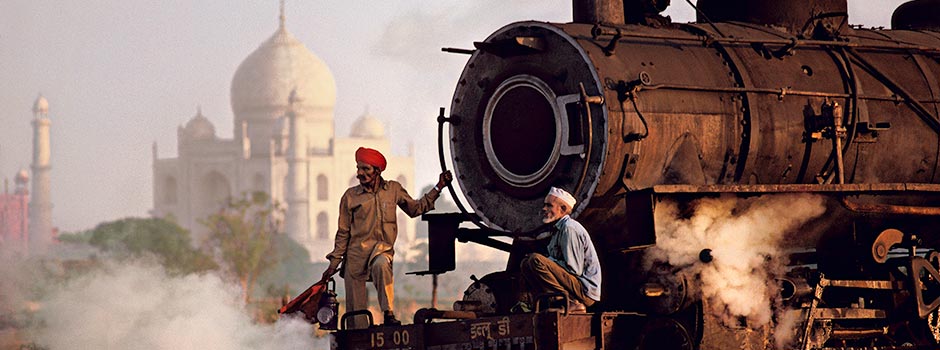
PHOTO EXHIBITION IN THE MUSEUM FÜR GESTALTUNG – SCHAUDEPOT, SWITZERLAND ( JUL 3 – OCT 18, 2015) Steve McCurry − Photographs from the East
Aug 21, 2015 Photography

Photographer Steve McCurry sees himself as chronicler who employs an intoxicating cosmos of images to tell us about disappearing cultures and the consequences of globalization. Often his photographs seem like stage sets that show people in their original life contexts. Fractures quickly become visible: McCurry describes himself as a photographer who operates on the “edges of the conflict.†The American takes his photographs in crisis-torn regions throughout the world and directs his camera at the people and landscapes left behind by war. McCurry achieved fame in 1979 when, disguised as a Mujahedeen, he smuggled the first photographs out of occupied Afghanistan. Several years later, in a refugee camp in Pakistan he took his most famous photograph, the picture of the green-eyed Afghan girl that has since become an icon. Direct attention is given to the person portrayed, but beyond this the torn clothing and, in particular, the girl’s fascinating gaze makes manifest the misery and horror of war.
Since his first trips to India and Afghanistan McCurry’s closeness to Asia has remained unchanged. For him the contrast to Western culture lies in public space and the blending of everyday life with religious life. Mosques and temples, but also simple religious scenes in the middle of the road, show that society in the Orient is permeated by religion to a far greater extent than in the West. The photographs make a particularly strong impact because they show a different side to that presented by the current ubiquitous reports on Islam which are so often accompanied by negative messages. McCurry questions viewers about their own view of this world religion.
_Steve_McCurry_Magnum_Photos.jpg) Steve McCurry, Men praying in a mosque, Srinagar, Kashmir, 1998, © Steve McCurry / Magnum Photos
Steve McCurry, Men praying in a mosque, Srinagar, Kashmir, 1998, © Steve McCurry / Magnum Photos
_Steve_McCurry_Magnum_Photos.jpg) Steve McCurry, Blue Mosque, Mazar-i-Sharif, Afghanistan, 1991, © Steve McCurry / Magnum Photos
Steve McCurry, Blue Mosque, Mazar-i-Sharif, Afghanistan, 1991, © Steve McCurry / Magnum Photos
_Steve_McCurry_Magnum_Photos.jpg) Steve McCurry, Taj and Train, Agra, Uttar Pradesh, India, 1983, © Steve McCurry / Magnum Photos
Steve McCurry, Taj and Train, Agra, Uttar Pradesh, India, 1983, © Steve McCurry / Magnum Photos
The exhibition, which consists of more than 130 works, presents one of the most influential reporter-photographers of the present day. They open a space for discussion about what photography today can and should be. It is impossible to overlook the fact that with his marked feeling for composition and color McCurry is committed to an overriding aesthetic and, in pursuit of this aim, reduces some things to playing a secondary role. His photographs seem to come from a different era, like the last pictures from a vanished time before mobile phones, sneakers and drinks in tin cans conquered the world. His oeuvre also makes clear that photography is far more than just recording a fleeting moment with the help of a camera.
_Steve_McCurry_Magnum_Photos.jpg) Steve McCurry, Sharbat Gula, Afghan Girl, at Nasir Bagh refugee camp near Peshawar, Pakistan, 1984, © Steve McCurry / Magnum Photos
Steve McCurry, Sharbat Gula, Afghan Girl, at Nasir Bagh refugee camp near Peshawar, Pakistan, 1984, © Steve McCurry / Magnum Photos
_Steve_McCurry_Magnum_Photos.jpg) Mujahideen observe a Russian convoy, Nuristan, Afghanistan, 1979, © Steve McCurry / Magnum Photos
Mujahideen observe a Russian convoy, Nuristan, Afghanistan, 1979, © Steve McCurry / Magnum Photos
“A picture can express a universal humanism, or simply reveal a delicate and poignant truth by exposing a slice of life that might otherwise pass unnoticed.†– Steve McCurry
Born 1950 in Philadelphia, Pennsylvania, Steve McCurry studied film at Pennsylvania State University, before going on to work for a local newspaper. After several years of freelance work, McCurry made his first trip to India, exploring the country and subcontinent with his camera. It was after several months of travel, that he crossed the border into Pakistan where he met a group of refugees from Afghanistan. They smuggled him across the border into their country, just as the Russian Invasion was closing the country to all western journalists. Emerging in traditional dress, with full beard and weather-worn features after weeks embedded with the Mujahideen, McCurry brought the world the first images of the conflict in Afghanistan, putting a human face to the issue on every masthead. Since then, McCurry has gone on to create stunning images over six continents and countless countries. His work spans conflicts, vanishing cultures, ancient traditions and contemporary culture alike - yet always retains the human element that made his celebrated photograph of the Afghan Girl such a powerful image. McCurry has been recognized with some of the most prestigious awards and his work has been exhibited worldwide.
Comments
Add a comment